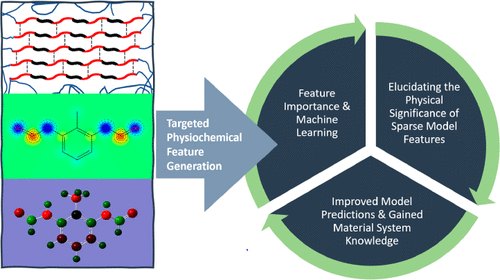当前位置:
X-MOL 学术
›
J. Phys. Chem. B
›
论文详情
Our official English website, www.x-mol.net, welcomes your
feedback! (Note: you will need to create a separate account there.)
Elucidating the Physicochemical Basis of the Glass Transition Temperature in Linear Polyurethane Elastomers with Machine Learning.
The Journal of Physical Chemistry B ( IF 2.8 ) Pub Date : 2020-09-08 , DOI: 10.1021/acs.jpcb.0c06439 Joseph A Pugar 1 , Christopher M Childs 2 , Christine Huang 2 , Karl W Haider 3 , Newell R Washburn 1, 2, 4
The Journal of Physical Chemistry B ( IF 2.8 ) Pub Date : 2020-09-08 , DOI: 10.1021/acs.jpcb.0c06439 Joseph A Pugar 1 , Christopher M Childs 2 , Christine Huang 2 , Karl W Haider 3 , Newell R Washburn 1, 2, 4
Affiliation

|
The glass transition temperature (Tg) is a fundamental property of polymers that strongly influences both mechanical and flow characteristics of the material. In many important polymers, configurational entropy of side chains is a dominant factor determining it. In contrast, the thermal transition in polyurethanes is thought to be determined by a combination of steric and electronic factors from the dispersed hard segments within the soft segment medium. Here, we present a machine learning model for the Tg in linear polyurethanes and aim to uncover the underlying physicochemical parameters that determine this. The model was trained on literature data from 43 industrially relevant combinations of polyols and isocyanates using descriptors derived from quantum chemistry, cheminformatics, and solution thermodynamics forming the feature space. Random forest and regularized regression were then compared to build a sparse linear model from six descriptors. Consistent with empirical understanding of polyurethane chemistry, this study indicates the characteristics of isocyanate monomers strongly determine the increase in Tg. Accurate predictions of Tg from the model are demonstrated, and the significance of the features is discussed. The results suggest that the tools of machine learning can provide both physical insights as well as accurate predictions of complex material properties.
中文翻译:

通过机器学习阐明线性聚氨酯弹性体中玻璃化转变温度的理化基础。
玻璃化转变温度(T g)是聚合物的基本性质,其强烈影响材料的机械和流动特性。在许多重要的聚合物中,侧链的结构熵是决定它的主要因素。相反,认为聚氨酯中的热转变由软链段介质中分散的硬链段的空间因素和电子因素共同决定。在这里,我们提出了T g的机器学习模型在线性聚氨酯中,旨在发现决定这一点的潜在物理化学参数。使用衍生自量子化学,化学信息学和形成特征空间的溶液热力学的描述子,对来自43种工业上相关的多元醇和异氰酸酯组合的文献数据进行了模型训练。然后比较随机森林和正则回归,以从六个描述符中建立一个稀疏线性模型。与对聚氨酯化学的经验理解一致,该研究表明异氰酸酯单体的特性强烈决定了T g的增加。T g的准确预测从模型中进行了演示,并讨论了这些功能的重要性。结果表明,机器学习工具既可以提供物理见解,也可以提供对复杂材料特性的准确预测。
更新日期:2020-10-30
中文翻译:

通过机器学习阐明线性聚氨酯弹性体中玻璃化转变温度的理化基础。
玻璃化转变温度(T g)是聚合物的基本性质,其强烈影响材料的机械和流动特性。在许多重要的聚合物中,侧链的结构熵是决定它的主要因素。相反,认为聚氨酯中的热转变由软链段介质中分散的硬链段的空间因素和电子因素共同决定。在这里,我们提出了T g的机器学习模型在线性聚氨酯中,旨在发现决定这一点的潜在物理化学参数。使用衍生自量子化学,化学信息学和形成特征空间的溶液热力学的描述子,对来自43种工业上相关的多元醇和异氰酸酯组合的文献数据进行了模型训练。然后比较随机森林和正则回归,以从六个描述符中建立一个稀疏线性模型。与对聚氨酯化学的经验理解一致,该研究表明异氰酸酯单体的特性强烈决定了T g的增加。T g的准确预测从模型中进行了演示,并讨论了这些功能的重要性。结果表明,机器学习工具既可以提供物理见解,也可以提供对复杂材料特性的准确预测。











































 京公网安备 11010802027423号
京公网安备 11010802027423号